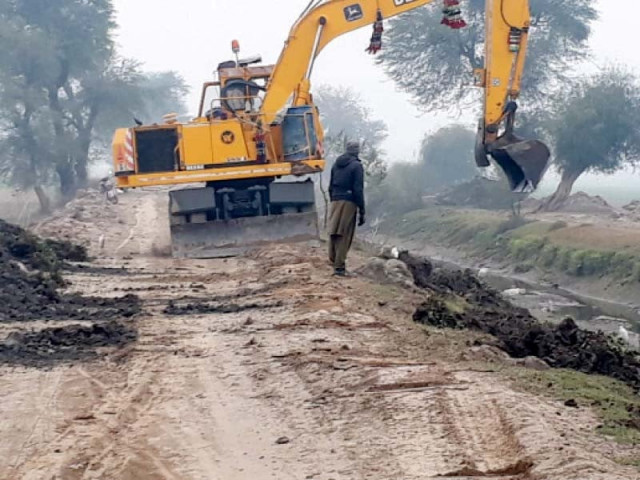Rs79b released for water projects in FY22
Rising population, climate change put water resources under immense stress

The government has released a record amount of Rs78.81 billion for water projects during the ongoing fiscal year 2021-22.
“Out of the total budget allocation of Rs90.31 billion, Rs78.81 billion has been released. It is expected that the remaining allocated budget will be utilised by June 2022,” revealed the Annual Plan 2022-23 released by the government.
Rising population, reservoir sedimentation, dwindling supplies and climate change impacts have put the country’s limited water resources under immense stress.
Storage enhancement coupled with conservative and efficient use of available water resources is direly needed for the provision of safe drinking water, sustainable agricultural and industrial growth, according to the report.
“The water resources sector’s ongoing development programme during 2021-22, costing Rs1,724.36 billion, focuses on water augmentation, water conservation, groundwater management, protection of infrastructure from water logging/ salinity and floods,” it said. Additional funding has been provided to the projects on fast track and near completion through re-appropriation for their timely closure.
Out of the 91 ongoing projects, 25 projects/ feasibility studies are likely to be completed by June 2022.
In Balochistan, Sindh, Punjab and Khyber-Pakhtunkhwa (K-P), about Rs26.77 billion is likely to be utilised during 2021-22 for the construction of medium/ small/ delay action dams and recharge dams.
During 2022-23, maximum funds, out of the total water sector allocation of Rs95.56 billion, are earmarked for the priority development programmes.
Under the strategic actions, focus will be on managing water requirements through the integrated water resources management and raising public awareness of the conservation of water by introducing technologies for water recycling and reuse.
Overall water availability (surface and groundwater) at farm gate hovers around 131.02 million acre fee (MAF). This includes 96.06 MAF of surface water against 100.62 MAF in 2020-21 at the canal head.
At farm gate, the surface water availability has remained at 80.23 MAF against 81.87 MAF in 2020-21.
“Improvement in surface water supplies at farm gate is mainly attributed to the reduction in conveyance losses on account of canal lining/ remodelling, rehabilitation/ modernisation of existing irrigation system, construction of small/ medium dams, check dams and retention weirs,” the report said.
Another 50.8 MAF of water supplies have been contributed to the system from the underground fresh water aquifer mainly by the private tube wells. However, “there is a need to study its impact on the groundwater table deterioration.”
Large and small dams
Out of the total water sector development programme amounting to Rs95.56 billion for 2022-23, an amount of Rs39 billion has been proposed for the construction of large and medium dams, including Rs27 billion for the Diamer Bhasha Dam and Rs12.06 billion for the Mohmand Dam, and Rs19 billion for small/ check and delay action dams across Pakistan.
“It is expected that about 15 ongoing medium/ small dam projects will be completed during 2022-23,” the Annual Plan said. An amount of Rs3.47 billion and Rs6 billion has been proposed for the Kachhi Canal Phase-I Part-A and B (remaining works) respectively to achieve the target of culture command area of 102,000 acres of agricultural land in Balochistan.
A sum of Rs5 billion has been proposed for the Nai Gaj Dam while Rs500 million has been proposed for the Naulong Dam for the development of 47,000 acres of culture command area in the Jhal Magsi district, Balochistan.
K-IV water supply scheme
To address the acute drinking water supply problem in Karachi, the ongoing project of 260 million gallons per day (MGD) of water supply has been allocated Rs20 billion in the Public Sector Development Programme (PSDP) for 2022-23.
To minimise the huge conveyance water losses and field application losses, the modernisation of existing irrigation system is under way with the help of federal PSDP. “It is proposed to gradually shift this programme for financing through the provincial ADPs (Annual Development Plans) in the coming years,” the report said.
An amount of Rs1.11 billion has been proposed for 2022-23 for the improvement/ rehabilitation/ modernisation of irrigation system and the lining of irrigation channels in saline zones.
Flood management
An allocation of Rs1.5 billion has been proposed for FY23 for completing small flood schemes all over Pakistan. A PC-I titled Flood Protection Services Project-III costing over Rs90 billion is being processed for approval.
Of the total allocation of Rs95.56 billion for the water sector during 2022-23, Rs76.6 billion is earmarked for Wapda, Rs17.46 billion for the provinces (Punjab, K-P, Sindh and Balochistan) and Rs1.5 billion for the normal/ emergency flood protection schemes.
The Global Climate Risk Index 2021 ranks Pakistan as the eighth most vulnerable country susceptible to the negative effects of climate change. According to the Annual Plan, the effects of climate change are being felt with greater intensity. During 2000-19, Pakistan has lost $3.7 billion annually on an average due to the climate change impacts.
Published in The Express Tribune, June 12th, 2022.
Like Business on Facebook, follow @TribuneBiz on Twitter to stay informed and join in the conversation.



















COMMENTS
Comments are moderated and generally will be posted if they are on-topic and not abusive.
For more information, please see our Comments FAQ